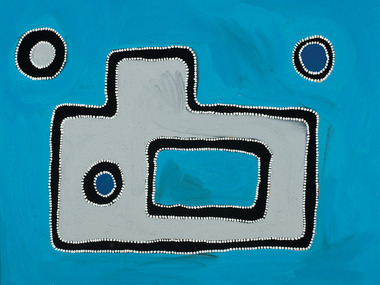Lavertys in The Netherlands

Rammey Ramsey, 'Untitled' 2008 Ochres on board, 80 x 100 cms
Posted by Jeremy Eccles | 20.01.12
Gallery: Aboriginal Art Museum
Dates:
20.01.12
: 10.06.12
The Lavertys - Colin and Liz - are legends in their own lifetimes. For they've not only built the largest Aboriginal art collection in this country – others overseas, such as the late John Kluge's, now at the University of Virginia may be larger – but they've done great things to promote both their collection and the artform.
For instance, two tomes called Beyond Sacred – the second last year an enlarged edition of the first – have been published with serious essays and accompanying exhibitions. Loans have been generously made to exhibitions all over the world. And now they have their own dedicated exhibition – Heart & Soul – opening today at the world's foremost Aboriginal art museum, AAMU, the Museum of contemporary Aboriginal art in Utrecht.
The show is a personal selection by the Lavertys, working with curator Georges Petitjean of the work of five of the most highly regarded artists in the Australian art world: Sally Gabori from a remote island in the Gulf of Carpentaria, for whom her art is her language, since only a handful of others speak her Kayardild tongue; Daniel Walbidi, a desert man driven to live on the coast of Western Australia and use its colours; Rammey Ramsey, an elder from the unique Jirrawun art centre in the East Kimberley; Naata Nungurrayi, from the tribe that started Aboriginal painting off at Papunya in 1971, now living on her own country at Kintore in the Central Desert; and Ginger Riley, a highly individual voice, painting the mythic landscapes of Arnhemland.
Their works are included in the collections of all major Australian art galleries and in international collections, and only Gabori has been seen before at AAMU. The selection shows the rich variety in Indigenous art from different regions – always a hard thing for foreign viewers to understand. For 'Aboriginal art' is not a homogeneous thing – but is a reflection of the 300 tribes that once peopled the Australian continent, of hugely different landscapes and mythologies, and of regional styles developing around art centres established in remote communities.
The Lavertys have not collected Blak indigenous art – which is fundamentally political. For their passion grew from Colin's earlier collection of hard-edged abstraction by artists like Dick Watkins and Peter Booth. And when the couple first encountered apparently abstract Aboriginal art in 1988 at the Brisbane Expo, it spoke a similar language to them. Their book, Beyond Sacred takes that approach even further. Essayists, including Colin argue that, though there are complex stories and spirituality behind their paintings, there is also an aesthetic intent in their chosen artists that is at least a match for the ethnographic role a painter may have to communicate lore within his or her community.
Georges Petitjean adds: “The focus on five artists enables us to present them as contemporary 'name' artists, which is still needed here in Europe in order to avoid the 'anonymous Aboriginal artist' label”. AAMU has previously taken the same attitude by showing Aboriginal art beside contemporary Dutch painters.
URL: www.aamu.nl
Share this:
»  del.icio.us
»
del.icio.us
»  Digg it
»
Digg it
»  reddit
»
reddit
»  Google
»
Google
»  StumbleUpon
»
StumbleUpon
»  Technorati
»
Technorati
»  Facebook
Facebook
Contact Details
Gallery: Aboriginal Art Museum
Email: info@aamu.nl
Telephone: +31 0 30? 238 01 00
Address: Oudegracht 176 Utrecht Utrecht 3511 Utrecht
Gallery: Aboriginal Art Museum
Email: info@aamu.nl
Telephone: +31 0 30? 238 01 00
Address: Oudegracht 176 Utrecht Utrecht 3511 Utrecht

Sally Gabori, 'Dibirdibi Country' 2009, Acrylic on linen, 137 x 121 cms
Where is the exhibition?
Further Research
Gallery: Aboriginal Art Museum
Artists: Daniel Walbidi | Dick Watkins | Ginger Riley | Naata Nungarryi | Peter Booth | Rammey Ramsey | Sally Gabori
News Tags: AAMU | Colin Laverty | Georges Petitjean | Liz Laverty
News Categories: Europe
Exhibition Archive
- 10.10.17 | TARNANTHI 2017
- 11.08.17 | Natsiaas 2017
- 20.07.17 | APY ART DOMINATES THE WYNNE
- 17.07.17 | Anangu Artist Wins $100,000 Prize
- 14.07.17 | The End of AAMU
- 11.07.17 | ART ACROSS THE COUNTRY
- 11.07.17 | TARNANTHI IN OCTOBER
- 05.07.17 | TJUNGUṈUTJA - from having come together
- 13.06.17 | Ghost-Nets Straddle the World
- 07.06.17 | Grayson Perry Going Indigenous?
- 05.06.17 | Barks Bigger than Ben Hur
- 27.05.17 | NGA QUINQUENNIAL 2017
- 21.05.17 | Blak Douglas Finds Home at the NGA
- 21.05.17 | BRIAN ROBINSON WINS HAZELHURST WOP
- 18.05.17 | PARRTJIMA 2.0
Advertising

